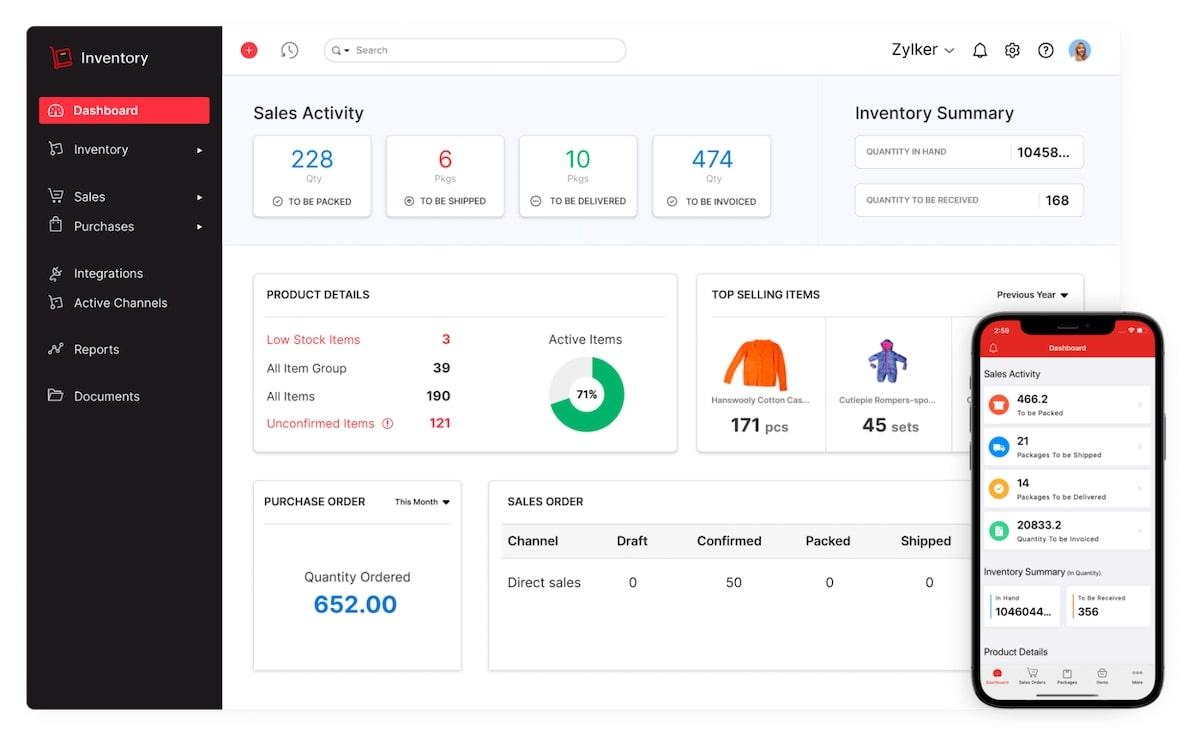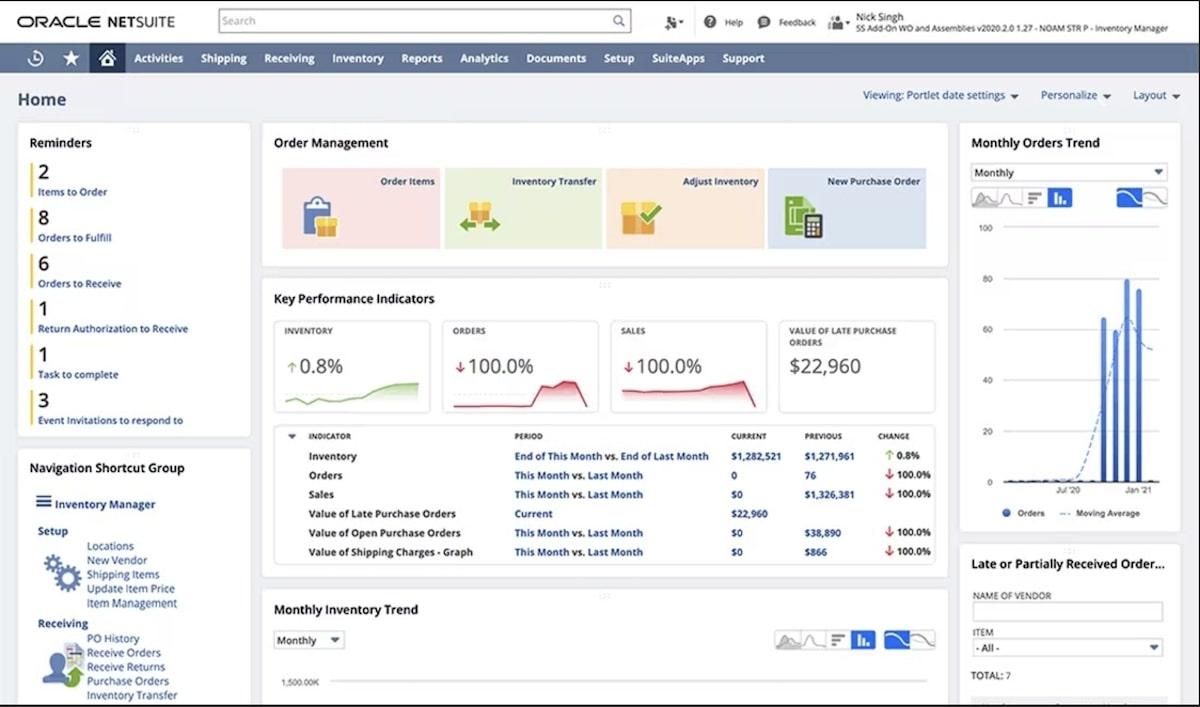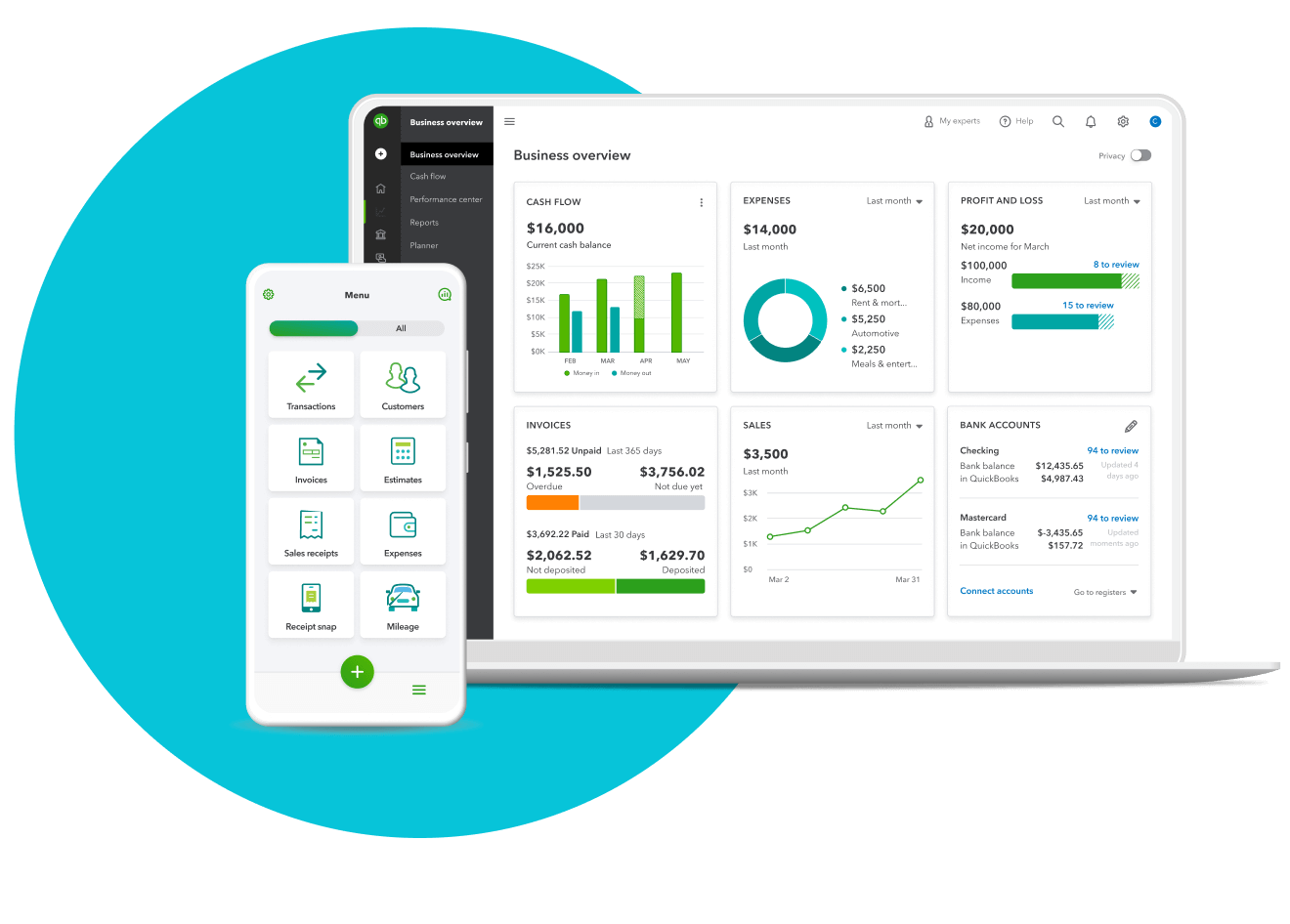Whether you’re running an e-commerce store, a physical retail shop, or a B2B business, having the right order management software is key to increased sales and customer satisfaction.
So where do you find the perfect tool for the job? Right here.
We’ve spent the past few weeks conducting thorough research, reviewing technical specs, and, most importantly, reading real user reviews. The result?
We’ve distilled the vast available options down to the top 10 order management solutions for this year and beyond, just for you. Stay with us, and we’ll guide you to the solution that aligns perfectly with your unique business needs. ?
What Is Order Management Software?
Order Management Software (OMS) is a digital command center for managing the entire order lifecycle. When you receive an order, it goes through a series of steps before reaching the customer—processing, inventory checking, shipping, and delivery tracking.
An OMS system centralizes and automates these processes. This means saying goodbye to spreadsheets, manual processes, and human errors—and saying hello to real-time inventory control and visibility, faster order processing, and a better overview to manage sales data and financial insights across your order management process.
How to Choose the Right Order Management System
Choosing the right order management systems for managing your business will save you from stress and headaches down the road. Here’s a short guide to making that decision without breaking a sweat.
- Look for inventory visibility software to manage orders that has an intuitive interface to ease the learning curve for yourself and your team
- Ensure the order management systems you choose offers adequate training, comprehensive resources, and responsive support for maximizing feature usage and resolving issues quicker
- Your OMS should easily integrate with the sales channels, accounting system, payment processors, customer relationship management (CRM) tools, and project management software used in your business
- Your chosen OMS should allow you to set up automated workflows for handling order requests, processing, tracking, and fulfillment
- Choose order management systems that can scale with your business—it should be able to handle increased sales channels and order volume, as well as additional team members, without taking a hit to performance ?
- Prioritize OMS options that have detailed reporting and analytics on sales, inventory, customer behavior, and team performance so you can take strategic action
10 Best Order Management Software
Here’s our curated list of the 10 best order management software available on the market today. Whether you’re a small retailer on the hunt for a simple system or a large enterprise looking for a do-it-all tool, this list has something for everyone. Let’s take a look.
1. ClickUp

ClickUp is an intuitive and versatile project management software that can easily be customized to fit your order management workflows. Use its custom fields to capture order details like order ID numbers, customer contact information, product specifications, and delivery timelines.
Another powerful feature is ClickUp Forms. It allows you to gather order details directly from customers using the custom fields you’ve set up. This makes taking orders smoother and more accurate from the very beginning. You can also use it to gather feedback to improve your products and your customer service.
Set up custom statuses to track orders in different stages like New Order, Packing, Fulfilled, and Delivered. ClickUp’s List and Kanban views are perfect for managing inventory and visualizing your order pipeline. With a simple drag-and-drop interface, you can easily update your inventory and move orders through the various pipeline stages.
Need to quickly talk about an order with your team? Instead of relying on external communication tools, simply comment on the task (that is, the order) in ClickUp. This keeps discussions contextually organized for future reference. Plus, notifications and reminders keep your team on top of inventory levels and order fulfillment deadlines. ⏰
And you don’t need to build your workflows from scratch. You can get started with any of ClickUp’s 1000+ free templates, which include:
- A product order form template for collecting customer orders and payment details
- An order fulfillment template for reducing the time taken to process, ship, and deliver orders
- A purchase order and inventory template for managing purchase orders
- A supply order form template for tracking business supplies and purchases
ClickUp best features
- Access ClickUp via the web and across multiple mobile and desktop devices with perfect sync
- Create custom dashboards to visualize sales order activity, assess team performance, and track progress toward business goals and key performance indicators (KPIs)
- Automate repetitive tasks with any of Clickup’s 100+ ready-made automations (e.g., when an order status changes, the person assigned to the order will also be changed)
- Integrate seamlessly with 100+ business tools including CRM systems like Salesforce, Hubspot, and Zendesk
- Watch ClickUp’s demo videos, tutorials, and webinars to get up to speed with its comprehensive features
ClickUp limitations
- Forms are limited on the free plan
- New users will need some time to get used to ClickUp’s extensive features
ClickUp pricing
ClickUp ratings and reviews
- G2: 4.7/5 (8,200+ reviews)
- Capterra: 4.7/5 (3,700+ reviews)
2. Zoho Inventory

Zoho Inventory is an online inventory management software for streamlining simple order and inventory workflows. You can track stock levels, manage multiple warehouses, and integrate with popular sales channels like Shopify, Amazon, eBay, and Etsy.
Unlike other tools, Zoho Inventory lets you display and sell products in multiple currencies, with automatic conversion to your base currency. It also integrates with major payment gateways like PayPal, Stripe, and RazorPay for accepting one-time or recurring payments.
Zoho Inventory best features
- Access Zoho Inventory via the web as well as Android and iOS mobile apps ?
- Use the barcode scanning feature for quicker and more accurate stock counting
- Connect with 25+ shipping carriers including DHL, FedEx, UPS, and USPS for real-time shipping rates and global order deliveries
- Integrate seamlessly with Zoho Books and other Zoho apps like Zoho Analytics and Zoho CRM
Zoho Inventory limitations
- Reports are basic and not customizable
- Users report inconsistent customer support
- Some say it has a complex setup
Zoho Inventory pricing
- Free
- Standard: $49/month
- Professional: $99/month
- Premium: $249/month
- Elite: $299/month
- Ultimate: $399/month
Zoho Inventory ratings and reviews
- G2: 4.3/5 (81 reviews)
- Capterra: 4.4/5 (372 reviews)
3. QuickBooks Online
QuickBooks Online is a cloud-based accounting platform for managing your business finances. It allows you to track income and expenses, manage bills and payroll, and generate detailed financial reports.
Beyond these accounting features, QuickBooks lets you connect with multiple sales channels like Amazon, Ebay, Shopify, Square, and Etsy to keep track of inventory levels. After a purchase is made, you can send out invoices for pending payments or sales receipts for completed payments. ?
QuickBooks Online best features
- Set it up so the sales tax is automatically applied to your invoices
- Connect QuickBooks directly to your bank accounts and credit cards
- Set item reorder levels, create purchase orders, and log items as expenses upon receipt and payment
- Generate financial reports like profit and loss, cash flow statement, balance sheet, and accounts receivable aging summary
QuickBooks Online limitations
- Users report that it sometimes gets glitchy after updates
- Customer support is reported to be a hit or miss
- Only the highest plans offer multichannel sales connection and inventory management
QuickBooks Online pricing
- Simple Start: $30/month
- Essentials: $60/month
- Plus: $90/month
- Advanced: $200/month
QuickBooks Online ratings and reviews
- G2: 4.0/5 (3,100+ reviews)
- Capterra: 4.3/5 (6,200+ reviews)
4. Jotform

Jotform is an online form builder for creating and sharing order forms. This allows you to gather relevant order details (like customer contact information, order specifications, and shipping information) and accept payments from customers. ?
Order submissions can easily be tracked and managed inside Jotform tables. Thanks to its native integrations, you can also choose to manage these submissions inside CRM tools like Hubspot and Salesforce or project management software like Trello and ClickUp.
Jotform best features
- Customize any of its 900+ order form templates to align with your brand’s style and collect order details
- Lets you translate order forms to 100+ languages including English, French, Spanish, Dutch, and Italian
- Allows you to connect with 40+ payment processors including PayPal, Stripe, Authorize.Net, and Square
- You can share access to your forms via links, QR codes, and webpage embeds
Jotform limitations
- Free plan only allows for five forms and 100 monthly submissions
- Users report that it gets slow and glitchy at times
Jotform pricing
- Free plan
- Bronze: $39/month
- Silver: $49/month
- Gold: $129/month
- Enterprise: Contact for pricing
Jotform ratings and reviews
- G2: 4.7/5 (204 reviews)
- Capterra: 4.6/5 (1,550+ reviews)
5. Linnworks

Linnworks streamlines inventory and order management across multiple e-commerce platforms and marketplaces like Amazon, eBay, Shopify, Magento, and WooCommerce. This synchronizes stock levels across the board and prevents overstocking and stockouts.
Automate shipping label creation and tracking by connecting directly with shipping platforms via Linnworks. Plus, its reporting and analytics tools provide a comprehensive view of sales performance and inventory status for strategic decision-making.
Linnworks best features
- Get an overview of top-selling products and those at risk of running out
- Automate repetitive tasks like creating purchase orders, assigning carriers, and merging multiple orders from the same customer for shipping ?
- Visualize financial performance across multiple e-commerce platforms over a specific time period
- Integrate directly with 30+ major carriers and third-party logistics providers like DHL, UPS, FedEx, and Easyship
Linnworks limitations
- Users report that it gets buggy at times
- Some users say pricing plans are expensive
- Customer support may take a few days to respond
Linnworks pricing
- Contact for pricing
Linnworks ratings and reviews
- G2: 4.3/5 (66 reviews)
- Capterra: 4.0/5 (26 reviews)
6. Brightpearl

Brightpearl is an order management platform tailored to multichannel wholesalers and retailers. It streamlines inventory tracking and multichannel order management across platforms like Amazon, eBay, Walmart, and Shopify. It also integrates with payment gateways, accounting software, and shipping providers to streamline your e-commerce operations.
A key feature is its ability to auto-save customer profiles, including contact details, order history, and past interactions. This makes it easy to reward your most loyal customers and create more personalized experiences for specific customer segments.
Brightpearl best features
- Lets you automate inventory allocation, order fulfillment process, and invoicing
- You can accept payments via seven gateways including PayPal, Stripe, Square, and Authorize.Net
- Use the inventory planner tool to forecast demand and always purchase the right products on time
- Visualize metrics like top-selling products, order value by country, revenue, ad spend, cost per conversion, and customer lifetime value
Brightpearl limitations
- Steep learning curve for new users
- Users report that it gets slow at times
Brightpearl pricing
- Contact for pricing
Brightpearl ratings and reviews
- G2: 4.5/5 (70 reviews)
- Capterra: 4.4/5 (150+ reviews)
7. NetSuite

NetSuite is an enterprise resource planning (ERP) solution for rapidly growing businesses and large enterprises that prioritize flexibility and scalability. It comes with customizable modules for tasks like invoicing, finance, inventory, and customer relations.
The dashboards give you and your team a clear snapshot of business performance metrics. And what’s even better: Its role-based access means everyone only sees the data relevant to their specific role. ??
NetSuite best features
- Add custom fields to gather and store details about each item in your database
- Set up taxes to be calculated automatically and applied to business transactions
- Create saved searches across various modules to quickly access datasets that match specific criteria
- Generate 100+ reports including inventory activity, sales by product (or lead source or promotion code), income, and cash flow statements
NetSuite limitations
- Customization requires specific technical skills
- Users report that it gets slow when updating an entry or loading reports
NetSuite pricing
- Contact for pricing
NetSuite ratings and reviews
- G2: 4.0/5 (2,600+ reviews)
- Capterra: 4.1/5 (1,300+ reviews)
8. Extensiv Order Manager
Extensiv Order Manager is designed for e-commerce businesses to streamline and synchronize their operations on a single platform. It achieves this by integrating with multiple e-commerce platforms, marketplaces, warehouses, shipping companies, and third-party logistics providers.
One of its standout features is the ability to auto-generate purchase orders with historical data and insights when item quantities hit certain thresholds. This ensures inventory levels are always primed to meet demand.
Extensiv Order Manager best features
- Bundle products and track inventory accurately, even when parts are sold individually ?
- Store and manage vendor details including their contact information, minimum order quantity, and lead times
- Set up rules to route orders to the right warehouse, split orders across multiple warehouses, and connect to the best shipping service
- Generate reports including inventory value and aging, stock-keeping unit (SKU) profitability, and demand forecasts
Extensiv Order Manager limitations
- PayPal is the only payment gateway available
- Users say that setup is complex and time-consuming
- Some say that it gets glitchy at times
Extensiv Order Manager pricing
- Contact for pricing
Extensiv Order Manager ratings and reviews
- G2: 4.5/5 (63 reviews)
- Capterra: 4.8/5 (107 reviews)
9. Google Forms

Google Forms is a free online form builder for small businesses that need a simple order management system. You can design forms with a variety of input types (like text, date and time, and drop-downs) to collect orders from customers.
Plus, customizing the form’s appearance with colors, fonts, images, and banners is a breeze. After creating your order forms, they can easily be shared via email, direct links, website embeds, and on social media platforms like Facebook and Twitter.
Google Forms best features
- Navigate its interface with ease even if it’s your first time
- Link responses to Google Sheets for further analysis
- Print all responses or download them as a CSV file
- Stop accepting responses with the toggle of a button
Google Forms limitations
- There are only a few templates and font types to choose from
- Expect limited integrations with third-party apps
Google Forms pricing
- Free
Google Forms ratings and reviews
- G2: No reviews
- Capterra: 4.7/5 (10,600+ reviews)
10. Odoo

Odoo is another ERP solution for unifying core business operations in one space. It has a user-friendly interface and a suite of apps for managing areas like inventory, sales and marketing, accounting, and human resources.
This modular design lets businesses start with essential apps and scale as needed. As an open-source software, it has a free community version that you can download and customize to fit your business needs. But if you’re looking to have online hosting, maintenance, and support, then the enterprise version is for you.
Odoo best features
- Access Odoo via the web as well as desktop and mobile devices
- Track inventory, product movement, and sales across all sales channels
- Integrate barcode scanners and point-of-sale (POS) systems with inventory for real-time data synchronization
- Generate custom reports on forecasted inventory, inventory valuation, and warehouse analysis
Odoo limitations
- User interface lags when working with bulky data
- Community edition doesn’t have all the Odoo apps, and some of the available apps have limited functionality
Odoo pricing
- One App Free: $0
- Standard: $9.10/month per user
- Custom: $13.60/month per user
Odoo ratings and reviews
- G2: 4.2/5 (225 reviews)
- Capterra: 4.1/5 (704 reviews)
Streamline Your Workflows With Order Management Software
With the top 10 order management software solutions at your fingertips, streamlining your business operations has never been easier. As you explore these options, consider how they each align with your specific business needs and goals so you can choose the right one.
And, hey, if you’re looking for a platform that beautifully marries order management with project and customer relationship management, then you should check out ClickUp. It might just be what your business needs to keep your customers and bank accounts smiling for a long time. ?







